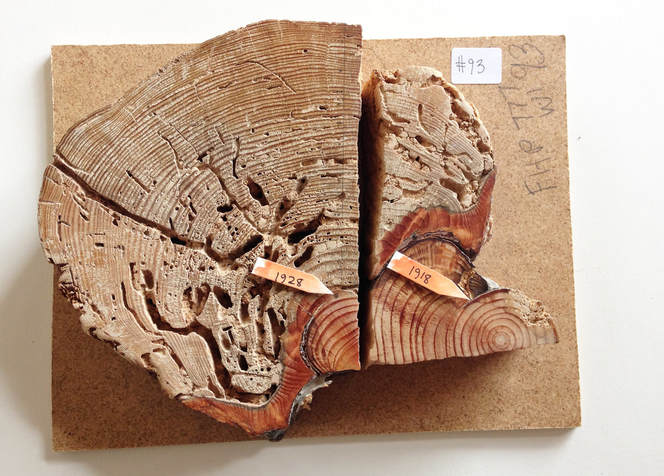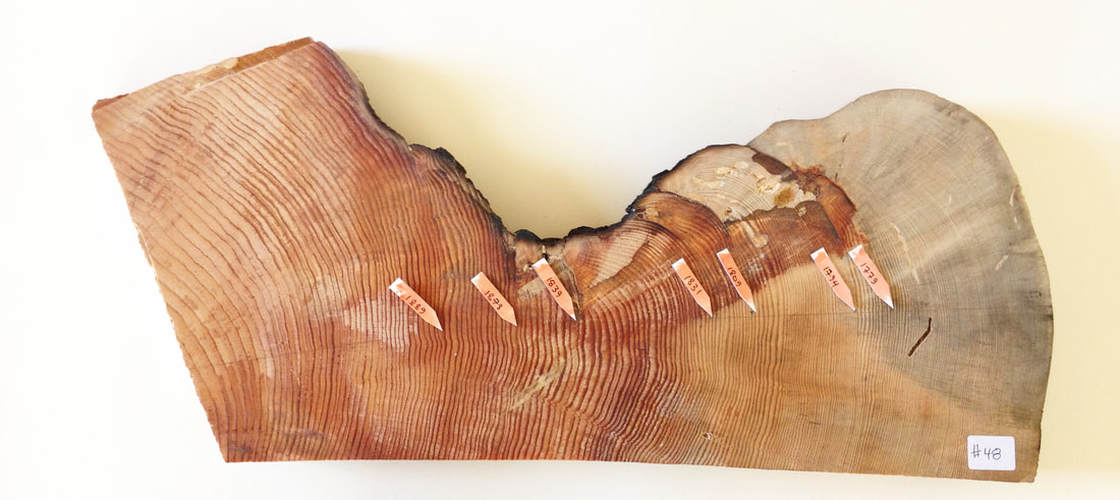Conifers capturing carbon in North Cascades National Park
Like all green plants, Ponderosa Pines, Douglas Firs, and other forest trees of the Pacific Northwest photosynthesize carbon from the atmosphere in order to grow. The dry wood of these conifers consists of about 47-55% carbon.
Fire Ecologist Karen Kopper and her colleagues have been sampling wedges and tree cores from hundreds of dead and living trees on the east side of North Cascades National Park to understand the history and severity of forest fires there and how the trees have responded over time. Tree rings from four old Ponderosa pines near Stehekin show that they continued to grow--to add carbon--over hundreds of years, surviving numerous low-intensity fires. I worked with Karen to tell the story of each of these individual trees, and weighed each sample to estimate the amount of carbon in it. The orange tags on the wood samples show the fire years.
The drawings and wood samples were part of the "Carbon Storylines" exhibit at the University of Washington Botanic Garden in February 2018.
Ponderosa Pine #52, c. 1689-2008
Like all green plants, Ponderosa Pines, Douglas Firs, and other forest trees of the Pacific Northwest photosynthesize carbon from the atmosphere in order to grow. The dry wood of these conifers consists of about 47-55% carbon.
Fire Ecologist Karen Kopper and her colleagues have been sampling wedges and tree cores from hundreds of dead and living trees on the east side of North Cascades National Park to understand the history and severity of forest fires there and how the trees have responded over time. Tree rings from four old Ponderosa pines near Stehekin show that they continued to grow--to add carbon--over hundreds of years, surviving numerous low-intensity fires. I worked with Karen to tell the story of each of these individual trees, and weighed each sample to estimate the amount of carbon in it. The orange tags on the wood samples show the fire years.
The drawings and wood samples were part of the "Carbon Storylines" exhibit at the University of Washington Botanic Garden in February 2018.
Ponderosa Pine #52, c. 1689-2008
Ponderosa Pine #93, c. 1913-1998
Ponderosa Pine #48, c. 1730-2006
Ponderosa Pine #94, c. 1804 - (living tree today)
The North Cascades fire history study as a whole will help the Park to manage fires in a way that protects forest ecology and natural fire regimes in the context of climate change. Restoring the earlier pattern of more frequent low- and moderate-severity fires helps to preserve the Park's forest as a carbon sink by reducing the odds of unnaturally severe fires that are more likely to kill trees and damage carbon-rich soils.
For more information about fire ecology in the national parks see: www.nps.gov/fire/wildland-fire/learning-center/fire-in-depth.cfm







